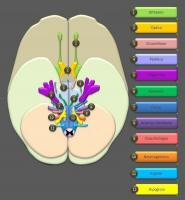BRAIN Project: what it is and how it intends to map the human brain
The brain is a complex set of organs that performs various functions such as maintaining and regulating the different vital functions of the body, as well as of the psychic functions, being the organ in which the conscience and the mind of the persons. Nevertheless, there is still a long way to go in research on the brain, which is why projects and research in this field have proliferated in recent years.
The BRAIN Project or the BRAIN initiative has been created in order to be able to map simultaneous communications in three dimensions of thousands of neurons so that in the future specialists in the field will be able to understand more clearly the functioning of the human brain and thus advance in the prevention and treatment of various diseases related to brain (eg. g., Alzheimer's, Parkinson's, etc.).
In this article we will see what the BRAIN Project consists of and what are the main objectives of this initiative.
- Related article: "The 15 Research Types (and Characteristics)"
What is the BRAIN project?
The BRAIN Project, also known as the BRAIN initiative (“Brain Research through Advancing Innovative Neurotechnologies” or “Brain Activity Map Project”), which could be translated into Spanish as "Brain research through the advancement of innovative neurotechnologies" or "Brain activity mapping project" is a human brain research initiative that was devised by the Spanish neurobiologist Rafael Yuste, having been announced on April 2, 2013 by United States President Barack Obama.
The BRAIN initiative or Project is based on the objective of achieve a three-dimensional map of the activity of each neuron in the human brain, making it possible to record the communications of thousands of neurons at the same time; In other words, what this project seeks is to map all the neuronal activity of the human brain and, in this way, understand how the most mysterious organ of all works.
This research has been outlined in a 15-year plan, so it is expected to end in 2026. It has an initial investment of 100 million dollars of federal funding and having channeled that budget through three agencies that are the Defense Advanced Research Projects Agency (DARPA), the National Institutes of Health (NIH) and the National Science Foundation (NSF), also having available various laboratories around the world participating in the draft.
Likewise, the BRAIN Project has also been funded by various private foundations such as the Howard Medical Institute Hughes, the Allen Institute for Brain Science, the Kavli Foundation or the Salk Institute for Biological Studies, among others, so the amount of financed money has risen considerably with respect to what had been invested initially.

- You may be interested: "Parts of the Human Brain (and Functions)"
Objectives of the BRAIN Project
The BRAIN Project is focused on developing a series of tools that enable scientists in charge of working and researching in the field of neuroscience and everything related to the human brain to achieve important discoveries, never achieved previously.
The Spanish neurobiologist who works at Columbia University in New York, Rafael Yuste, affirms that the advances that are anticipated as a result of the BRAIN Project in the future could allow scientists to treat, cure and/or prevent brain disorders or diseases like Alzheimer's or the Parkinson's, as well as traumatic injuries, as well as providing more in-depth knowledge about the basic science that studies and investigates the functioning of the brain.
Another of the advances that is expected to be achieved thanks to the BRAIN Project is the development of different prostheses that help link the brain directly to the Internet, thereby achieving unprecedented progress in solving a number of problems that have been difficult to tackle to date. The researchers of this project hope that their investigations offer the possibility of capturing real-time imaging of neural circuitry at a speed similar to our thinking.
For this, it has been necessary for various professionals to have joined the BRAIN Project, such as molecular biologists, neurobiologists, geneticists, mathematicians or computer scientists, among others, in an interdisciplinary collaboration that requires the invention of new techniques and the development of advanced technologies.
In addition to being able to map the 80,000 million neurons and their connections, other advances that are expected in the coming years will be the proliferation of brain devices, so the researchers of the BRAIN Project consider that the brain should be protected at the legislative level throughout the world, must include the neurorights in the Charter of the United Nations in order to protect the activity and data of the brain when they are carried out technological transplants in the brain, which must be considered and regulated as medical devices and not as technological products of consumption.
- Related article: "Types of neurons: characteristics and functions"
Criticism of the BRAIN project
Since the BRAIN Project was announced in 2013, it has not been without criticism, because considered by many to be overly ambitious with unrealistic expectations. It has been argued that mapping an activity as complex as that carried out by billions of brain neurons is not possible. On the other hand, there were those who did believe that it would be possible to achieve it but that it would entail high costs.
Others who saw it feasible for the BRAIN Project to map neuronal activity considered that later they would encounter serious difficulties when it comes to managing and working with the vast amount of data that they could obtain from a three-dimensional map of neural connections. Based on these possible difficulties, Yuste and his collaborators affirm that they will need new technological tools and techniques that allow the brain to be studied in greater depth, which will make it possible to move forward with the project.
There were also those who were more critical of this project, arguing that even if they managed to map all the neural spikes simultaneously it would not be a complete record because it would be necessary to record at the same time the external stimuli to which the brain was exposed at that moment, so that the brain could be analyzed and understood at a macroscopic level.
Achievements attributed to the project
In favor of the BRAIN Project, it is worth mentioning that in early 2021 Alipasha Vaziri and her team from Rockefeller University (USA) USA) reported in an article that had managed to simultaneously record the activity of more than a million neurons in the cerebral cortex of a mouse, being the largest record of animal cortical activity to date. However, it is still quite far from what was promised when the project was announced when it was expected that they would be able to record the activity of millions of neurons in the human brain.
Another of the most important results that have been achieved in the BRAIN Project has been the development of a classification of cell classes in the motor cortex of humans and mice, which has made it possible to give a great deal of knowledge about the way in which the brain is organized.
In the final phase of the BRAIN Project they will seek to understand how the different circuits of the brain work through a diagramming of the interconnected neurons, being more modest objectives than the initial ones given that they have been able to observe throughout Throughout these years of research to understand the brain should be a continuous task that should not be put a deadline.
As we have seen, there is still a long way to go in the field of brain and neuroscience research and, although there are various lines of research that are very promising, we must be cautious because it is possible that these long-awaited advances could take longer than previously promised, or maybe not; In any case, there is still a long way to go in a field of research as curious, exciting and mysterious as the study of the human brain.



